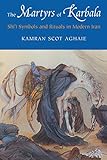The martyrs of Karbala : Shi'i symbols and rituals in modern Iran / Kamran Scot Aghaie.
Material type: TextSeries: Publications on the Near East, University of WashingtonPublication details: Seattle ; London : University of Washington Press, 2004.Edition: 1st edDescription: 1 online resource (xvi, 200 pages) : color illustrations, mapsContent type:
TextSeries: Publications on the Near East, University of WashingtonPublication details: Seattle ; London : University of Washington Press, 2004.Edition: 1st edDescription: 1 online resource (xvi, 200 pages) : color illustrations, mapsContent type: - 9780295800783
- 029580078X
- Shīʿah -- Iran -- History
- Shīʿah -- Iran -- Tehran -- Case studies
- Muslim martyrs -- Iraq -- Karbalāʼ
- Shīʿah -- Customs and practices
- Islam and politics -- Iran
- Chiisme -- Iran -- Histoire
- Chiisme -- Iran -- Téhéran -- Études de cas
- Martyrs musulmans -- Irak -- Karbalā'
- Chiisme -- Coutumes et pratiques
- RELIGION -- Islam -- Shi'a
- HISTORY -- Middle East -- General
- Islam and politics
- Muslim martyrs
- Shīʻah
- Shīʻah -- Customs and practices
- Iran
- Iran -- Tehran
- Iraq -- Karbalāʼ
- Muharram
- Prozession
- Ritual
- Schiiten
- Symbolik
- Iran
- Sjiʻisme
- Riten
- Symbolen
- Chiite
- Histoire religieuse
- Martyr
- Relation Église-société
- Rituel religieux
- 1850-1899
- 20e siècle
- Iran
- Karbala -- Schlacht
- Geschichte 1796-2001
- 297.8/2/0955 23
- BP192.7.I68 A37 2004eb
- online - EBSCO
- 11.83
| Item type | Current library | Call number | URL | Status | Notes | Barcode | |
|---|---|---|---|---|---|---|---|
 eBook
eBook
|
Biblioteca "Angelicum" Pont. Univ. S.Tommaso d'Aquino Nuvola online | online - EBSCO (Browse shelf(Opens below)) | Online access | Not for loan (Accesso limitato) | Accesso per gli utenti autorizzati / Access for authorized users | (ebsco)407733 |
Includes bibliographical references (pages 179-193) and index.
A brief historical background of Shi'ism and Moharram -- The Qajar elites and religious patronage (1796-1925) -- Qajar society and religious culture : Tehran as a case study -- The Pahlavi regime and the emergence of secular modernism (1925-1979) -- Religious rituals, society and politics during the Pahlavi period -- Hoseyn "the prince of martyrs" -- Fatemeh, Zeynab, and emerging discourses on gender -- The Islamic republic.
"This study examines patterns of change in Shi'i symbols and rituals over the past two centuries to reveal how modernization has influenced the societal, political, and religious culture of Iran." "Moharram symbols and rituals are among the most pervasive and popular aspects of Iranian culture and society. The Martyrs of Karbala traces patterns of continuity and change in three aspects of Iranian life: the importance of these rituals in promoting social bonds, status, identities, and ideals; the ways in which three successive regimes (Qajars, Pahlavis, and the Islamic Republic) have either used these rituals to promote their legitimacy or have suppressed them because they viewed them as a potential political threat; and the uses of Moharram symbolism by opposition groups interested in overthrowing the regime."--Jacket
Print version record.


